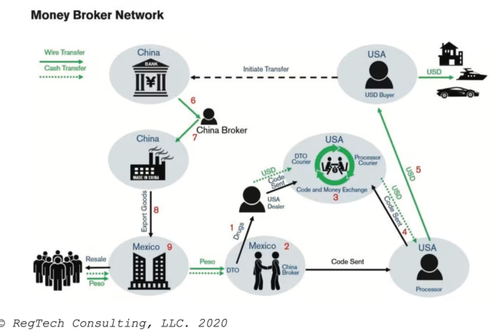It's worth noting that 100,000 Americans die in drug-related deaths per year, the vast majority from pills cooked with fentanyl, an opioid analog 50 times more potent than heroin. Every six months, the US drug death catastrophe eclipses the Vietnam War.
Fueling the fentanyl epidemic across the US are Chinese money launderers helping international drug traffickers, like Mexican cartels. Capital flight from China is not a new phenomenon, but in recent years, the scale of these transfers, washed through the drug trade, has become very alarming.
Paul Murphy from the Financial Times has provided the most straightforward explanation yet of the new Chinese money laundering network fueling America's fentanyl crisis:
First, understand that Chinese nationals are barred from transferring more than $50,000 out of China each year. And yet, as you are surely aware, there are many many Chinese nationals living very comfortable lives in the west, as students perhaps, or tourists, or simply not working.
Now understand that Mexican drug cartels are harvesting untold billions of dollars, in cash, selling drugs in North America — and that the pill of the moment is fentanyl, which kills about 70,000 people a year in the US.
The chemicals to make fentanyl come from China. These are shipped to Mexico by otherwise legit Chinese chemical manufacturers.
In Mexico, the cartels turn the chemicals into pills and smuggle these north across the border, where they are sold for cash — dollar bills that then need to be cleaned.
Murphy continued:
Meanwhile, in New York for instance, there will be a Chinese student attending an educational establishment, where the fees will be circa $66,000 a year, books and extras another $10,000, food and lodging costs of maybe $5,000 a month, or a lot more.
The $50,000 Chinese transfer cap doesn't cover these things, so she will go on WeChat and broadcast a message to her network of friends saying: "I need dollars in New York to meet my outgoings. Can anyone help?"
In due course, someone associated with what is a very efficient Chinese underground banking system will get in touch and tell the student to meet a courier at a preordained time and place, typically a park in Brooklyn. There, the student will be handed a bundle of cash.
Back in China, the parents of the student will then be asked to transfer the same amount of money (plus commission) to an account that will eventually make its way to the chemical company that produced the precursor ingredients for fentanyl, settling the outstanding bill for the Mexican drug cartel.
Murphy explained, "Drug addicts in the US are facilitating the Western education of Chinese youth, as well as helping to fund the lifestyles of other Chinese nations living outside China."
He provided a flow chart showing how the complex laundering system works.

In a separate report last week, FT's Joe Miller and James Kynge published an in-depth analysis of the Chinese-Mexican laundering network in a report titled "The new money laundering network fuelling the fentanyl crisis."
The report sheds light on the less understood part of the money laundering operation — the demand for dollars from wealthy Chinese individuals. While capital flight from China is not new, the methods have become increasingly creative, involving chemical companies that, in turn, have fueled America's opioid epidemic.
"The levels of capital flight in the past three years have been quite alarming," one senior Chinese official told FT, adding, "Some wealthy private entrepreneurs are losing confidence in China's future. They feel unsafe, so they find ways to get their money out."
Brad Setser, a former US Treasury official and an expert on global capital flows at the Council on Foreign Relations, estimated that capital flight from China is running at an annualized rate of about $516 billion as of 1Q24. This figure was even higher in the 3Q22, reaching almost $738 billion.
"The whole system of drug trafficking is being sustained by a network of clandestine [Chinese] money brokers," said Giovanni Melillo, the chief prosecutor for Italy's National Anti-Mafia and Terrorism Directorate. His office has been coordinating laundering probes across Italy this past year.
Previous cases of money laundering in the US involving Chinese nationals have raised serious questions about how much Beijing knows about these dark laundering networks. For instance, a recent Wall Street Journal report revealed that Chinese crime groups and drug traffickers used the Toronto-Dominion Bank to launder money from US fentanyl sales.
In mid-April, the House Select Committee on China revealed that the Chinese Communist Party used tax rebates to subsidize the manufacturing and exporting of fentanyl chemicals to overseas customers.
The biggest mystery here is why the Biden administration hasn't taken a tougher stance on China while America's fentanyl epidemic kills as many citizens each year as two Vietnam Wars.
